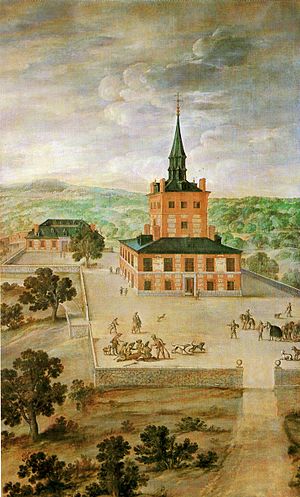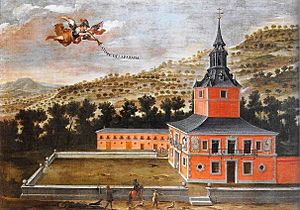Torre de la Parada facts for kids

The Torre de la Parada was a special building used for hunting. It was located in an area called Monte de El Pardo, near the Royal Palace of El Pardo. This spot is outside the city of Madrid, in the Sierra de Guadarrama mountains. Most of the lodge was destroyed by fire in 1714. This happened when Austrian soldiers captured it during the War of Spanish Succession. Even today, some ruins of the building can still be seen.
History of the Hunting Lodge
Building the Lodge
The Torre de la Parada was first built between 1547 and 1549. The architect who designed it was Luis de Vega. Later, from 1635 to 1640, King Philip IV of Spain decided to make big changes to the lodge. King Philip IV loved hunting very much.
In 1636, he asked a Spanish architect named Juan Gómez de Mora to update the building. The king also wanted the lodge to be filled with beautiful art. He hired some of the most famous painters of the time to decorate it.
Art and Artists at the Lodge
Two of the most important artists who worked on the Torre de la Parada were Rubens and Velázquez.
Velázquez painted several famous portraits for the lodge. These included paintings of "jesters," who were entertainers at the royal court. Some of these portraits are The Jester Don John of Austria and The Jester Don Diego de Acedo. He also painted Portrait of Francisco Lezcano and Portrait of Pablo de Valladolid. His paintings of Aesop and Menippus were also likely made for the lodge. Velázquez also created portraits of the royal family in their hunting clothes, like Prince Balthasar Charles as a Hunter.
In 1636, Rubens was asked to create sixty paintings about myths. He finished all these paintings in about 18 months! He had help from other artists like Jacob Jordaens and Cornelis de Vos. These artists worked from Rubens's own designs. Today, forty of these paintings still exist. Many of Rubens's original oil sketches and drawings for these works also survive. Most of these amazing artworks are now in the Prado Museum in Madrid.
Later, some of the best paintings were moved to other places, especially around 1710. In 1806, a travel book mentioned that the lodge still had paintings by other Flemish artists. These included Paul de Vos, Erasmus Quellinus II, and Thomas Willeboirts Bosschaert.
See also
 In Spanish: Torre de la Parada para niños
In Spanish: Torre de la Parada para niños


